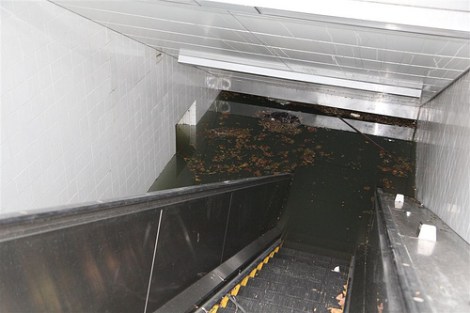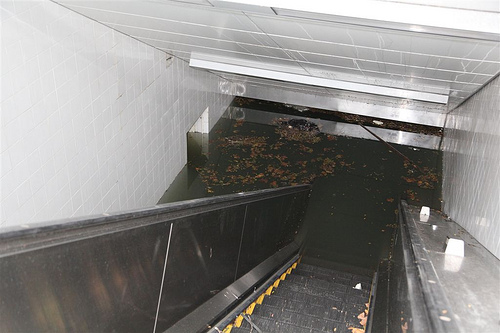
MTAPhotosAn escalator at the South Ferry subway stop leads into an East River annex.
This morning, hundreds of thousands of New Yorkers head in to work for the first time since last Friday — and for the first time many of them are trying to figure out how to get there without the subway. The subways are, in Bill McKibben’s eloquent words, “the most crucial element of that magnificent ecosystem,” a system unseen but heard and felt like a heartbeat. It’s quiet now.
From The New York Times:
For buildings ancient and modern, devastation arrived in the same breath on Monday night: not in howling winds, but in the murmur of the Hudson River. At Spring Street, the river waters carried over the east bank, moved across West Street, spread past Washington and Greenwich Streets and then most of the way to the street named for the river, Hudson.
That is: the river moved 1,200 feet inland, nearly a quarter-mile.
We have reached the moment of the instructive catastrophe, our vulnerability bared by forces that we can no longer pretend are some civil engineer’s bad dream. In the summer of 1991, I watched a kind of horror movie. Federal emergency planners ran a slide show of pictures of familiar New York sites that had been doctored to show the effects of a Category 4 hurricane on the city. The entrance to the Brooklyn-Battery Tunnel, nine feet underwater. Nathan’s in Coney Island, fully submerged. Diapers floating off the shelves at the Toys “R” Us on the Belt Parkway in Brooklyn. Kennedy International Airport, 24 feet underwater. It seemed far-fetched.
On Monday night, more than two decades later, I stood in Hudson River water at Hudson Street, and have the wet sneakers to prove it.
Pumps are still sucking water from the city’s flooded subway tunnels, with questionable success …
“Our pumps are working. It’s just that the water has no place to go,” MTA spokeswoman Judy Glave said. “We pump it out and it just comes back in.”
… but conversation has understandably already turned to prevention, how the city’s subways and infrastructure can be protected from the next massive storm.
From the Times:
On Tuesday, as New Yorkers woke up to submerged neighborhoods and water-soaked electrical equipment, officials took their first tentative steps toward considering major infrastructure changes that could protect the city’s fragile shores and eight million residents from repeated disastrous damage.
[New York] Gov. Andrew M. Cuomo said the state should consider a levee system or storm surge barriers and face up to the inadequacy of the existing protections. …
The Cuomo administration plans talks with city and federal officials about how to proceed. The task could be daunting, given fiscal realities: storm surge barriers, the huge sea gates that some scientists say would be the best protection against floods, could cost as much as $10 billion.
But many experts say, given what happened with the latest storm, that inertia could be more expensive.
Cuomo, as we mentioned yesterday, recognizes the “new reality” of a changed climate (though New York City Mayor Michael Bloomberg made an oblique reference last night to there being a question about causation). Since January 2010, the city has seen the warmest day in its history, its snowiest month, and the largest tropical storm in Atlantic history. The time for worrying about whether or not we can take climate action sufficient to prevent flooding of New York City is obviously past. The question now is how to prepare adequately for the future.
This was the line of people waiting for a bus in Brooklyn to get in to work this morning.
From Ocean Parkway & Church Ave., BK where B35 and Express #Bus to Manhattan meet. #sandy #MTA #transit #brooklyn twitter.com/TWULocal100/st…
— TWU Local 100 (@TWULocal100) October 31, 2012
And this, cars on Park Avenue.
This is what it looks like when New Yorkers all try to go back to work without subways. twitter.com/nowthisnews/st…
— NowThis News (@nowthisnews) October 31, 2012
The broken subway system means New York is broken. The Times notes that warnings that this could happen echoed in silence for years. That can’t — and hopefully won’t — continue. As Ben Strauss of Climate Central said to the Times:
Three of the top 10 highest floods at the Battery [in lower Manhattan] since 1900 happened in the last two and a half years. If that’s not a wake-up call to take this seriously, I don’t know what is.
Update: The Atlantic Cities has a good overview of how flooding could be prevented in the future.
Note: Bill McKibben and Ben Strauss serve on Grist’s board of directors.



